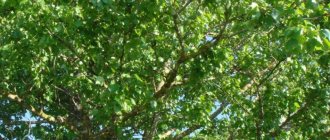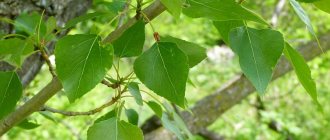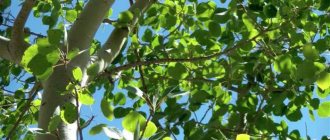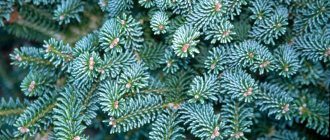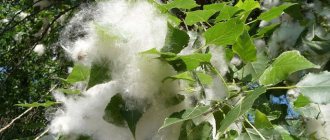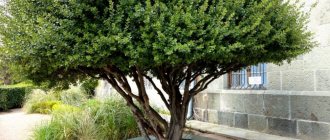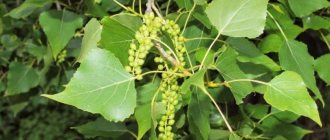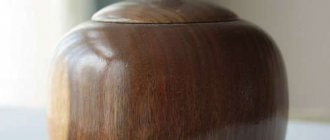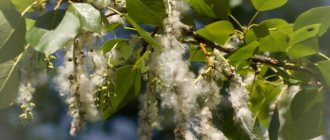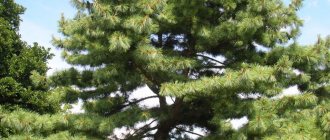Characteristic
The pyramidal poplar, a photo of which is given in the article, belongs to the large Willow family. It is distributed in Russia, Ukraine, Italy, Central Asia and the Caucasus, and presumably its homeland was the Himalayas or Afghanistan. This tree with a narrow, columnar crown grows up to 30-45 m in height, and its trunk can reach up to 1 m in girth. The crown diameter is on average 4-5 m. The root system is powerful, voluminous, going deep into the ground. It can be up to 1/3 of the length of the tree itself.
The strong, erect branches of the crop are covered with dark gray bark with numerous cracks. The triangular-shaped leaves are dark green and turn yellow in the fall. They appear on the tree at the end of April and fall off by October.
The culture blooms in mid-spring. At this time, inflorescences form on the tree - earrings, colored dark red in male trees and white in female trees. By the beginning of summer, they form elongated boxes with seeds covered with fluff.
Poplar pyramidal
The most common pyramidal poplars are of the male type. They do not produce much fluff, and are grown for landscaping public gardens and parks. But this tree has a peculiarity - in unfavorable environmental conditions, earrings of a “fluffy” female type are formed on it.
Frost resistance of poplar is high, and it tolerates temperature drops down to -30 °C. But it may suffer in severe cold weather. Suitable for cultivation in southern and central regions with temperate climates. It is a long-livers and can grow for 300 years.
Soviet
A tall subspecies of tree, bred in 1937. It is characterized by fast growth and wind resistance. Adapts to polluted environments and can grow on depleted and slightly saline soils. It can withstand severe frosts, but does not bloom in the middle zone and in the north. Reaches up to 30 m in height.
Chinese
A relatively low-growing subspecies of tree, the height of which does not exceed 15 m. It is more common in Asian countries. It is distinguished by thin shoots and wide leaves.
Does not tolerate drought well, during which it can lose all its foliage.
Black
A tall tree species characterized by diamond-shaped leaves and dark gray bark. It blooms in early spring, producing a large amount of fluff. Due to the strong fire danger, it is recommended for growing near water bodies. Life expectancy is shorter than that of other subspecies and is 60-80 years. Withstands frosts down to -30 °C, and is not suitable for growing in northern regions.
Varieties of pyramidal poplar
Today, the following three types of plants are common:
Soviet
Up to 30 meters in height. The crown is dense and narrow. Tolerates frost and winter well. Growing quickly.
Chinese
Up to 15 meters high. The shoots are thin, growing upward, slightly ribbed. The leaves are quite long - up to 12 cm.
Preparation of planting material and propagation
Pyramidal poplar, a photo of which confirms its tallness, is usually grown from seedlings that can be purchased at specialized nurseries. When purchasing a tree, it is important to evaluate its condition. A healthy seedling should have light bark without damage and several developed shoots. It is also worth assessing the root system of the crop. It should not contain damaged or rotten shoots.
You can also get healthy pyramidal poplar seedlings from seeds or cuttings. But these methods take a lot of time.
Growing poplar from seeds
You need to start growing poplar from seeds in late spring - early summer, when the crop begins its flowering period. Planting material can be collected both from the ground and directly from the tree.
And the reproduction process itself consists of the following stages:
- Dig up the soil, clearing it of weeds and debris.
- Add humus to the soil using 1-2 kg per 1 square meter. m. Loosen the bed and level it with a rake.
- Distribute the collected boxes evenly over the soil surface. They can also be planted in rows. But in any case, you cannot bury the seeds, otherwise they will not sprout.
- Gently spray the planting with warm water from a spray bottle. It is advisable to cover the planting material with a transparent film for 5-7 days.
- Spray the soil with warm water, keeping it moist.
The first shoots will appear on day 8-9. When the seedlings grow to 5-7 cm in height, the planting should be thinned out, leaving the strongest and healthiest plants. At the same time, a distance of 10-15 cm should remain between them. The seedlings must be watered periodically and planted in a permanent place in September.
Growing poplar from cuttings
It is better to start this activity in early spring, before the buds open. For propagation, it is better to use annual shoots located at the ends of powerful and healthy branches. Also follow the area for planting, thoroughly loosening the soil and removing weeds and debris.
The process itself should be carried out according to the following algorithm:
- Cut the selected shoots into cuttings 15-20 cm long. It is important that each piece has about 3-5 healthy buds.
- Water the soil generously with warm water.
- Plant the cuttings vertically so that the bud is level with the ground. At the same time, it is advisable to deepen the shoots to at least ¼ of their length. Maintain a distance of 50 cm between branches.
- Cover the planting with agrofibre for the first time.
Plant care consists of regular watering, which should be done as the top layer of soil dries. When the cuttings take root and reach a height of 15-20 cm, watering must be reduced.
Varietal types of poplar.
- Snow-white - grows quickly up to 20 meters in height, reaching its maximum size in 20-30 years;
- spherical - small in size, does not have white pubescence on small leaves;
- weeping also has small dimensions and long hanging shoots;
- Richard - is a small tree or bush-like form, the height of which does not exceed five meters. The large golden leaves have silvery pubescence on the underside, which makes the plant especially attractive when viewed from afar. The spectacular tree is delightful in group plantings in large gardens, and the bush - in single form, in compositions with small-sized cultural plantings;
- pyramidal - with a neat pyramid-shaped crown, which makes it possible to use it to decorate alleys and walking paths, places at the entrance to buildings, stairs, intersecting sections of embankments with city streets.
For decorative purposes, the following types of poplars are used:
- white, a modified form of a wild tree, which is adapted for growing on personal plots, in city parks and squares. The maximum height is 1-1.5, which allows it to be used in flower beds;
- trembling - grows very quickly to a small size, has a very lush crown;
- Ontarian - grows up to 8-9 meters in height and is often used to create poplar alleys and groves. It is distinguished by decorative leaves of light green color with beige or red splashes.
Preparing the soil and planting site
Pyramid poplar is an unpretentious species. But in order for the tree (photos of seedlings are given in the article) to develop faster, it is worth planting it in a lighted open area. And it is better to choose a place with loose, fertile soil with a neutral or slightly acidic reaction, since plant growth slows down in clayey, heavy soils.
You can prepare the substrate by mixing the following components in equal parts:
- garden soil;
- peat;
- sand.
When choosing a location, it is worth considering that the roots of the poplar grow strongly. So the tree should be planted 40-50 m from buildings.
Poplar in landscape design
A special property of poplar is its ability to purify polluted air. Therefore, by growing poplar both in park alleys and in garden plots, it will perform two tasks at once - creating a unique look that the tree gives and improving the urban ecology.
In order to avoid the summer fluff for which poplar is famous, you can plant males. This approach will greatly simplify the situation for those for whom poplar fluff is a stumbling block when choosing a tree to plant.
Landing algorithm
It is better to plant pyramidal poplar seedlings in the fall, around September - October. But it is important to carry out this event 3-4 weeks before the onset of cold weather, so that the trees have time to take root in the new place. You can also plant in the spring, but it is better to choose the period before the buds open. Otherwise, the seedlings will take a long time to take root.
The landing itself must be carried out according to the following algorithm:
- For the plant, dig a planting hole with a width and depth of 1 m. If several seedlings are planted, then maintain a distance of 3-4 m between them.
- Fill the hole 1/3 with drainage. You can use expanded clay, broken brick or pieces of slate for this. Sprinkle the drainage with fertile soil, creating a small hill in the middle.
- Place the seedling in the center of the hole on a hill and smooth out its roots. Place a support near the tree.
- Mix the soil with nitroammophoska (100 g). Gradually fill the holes with the mixture and lightly compact its surface. It is important that the root collar of the plant is level with the ground.
- Make a watering circle by pouring a hill with a height of 4-5 cm around the perimeter, retreating 0.5 m from the trunk.
- Tie the tree to a support and water it, pouring 10-15 liters of water under each plant.
After planting, it is advisable to mulch the surface of the tree trunk circle with peat or sawdust.
Care
Pyramidal poplar (the photo clearly demonstrates the slenderness of the crown) is one of the most unpretentious trees. And care is necessary only for young seedlings, the first 5-6 years after planting. Later they grow without any attention.
Spraying and watering
An adult pyramidal poplar needs enough precipitation and groundwater. But young trees need regular watering. It must be carried out every 10-14 days, using 25-30 liters of water for each seedling.
After watering or precipitation, the soil surface in the tree trunk circle must be loosened. This measure will prevent the formation of a dense crust that blocks air access to the roots. During loosening, you should also weed the soil, removing weeds. They absorb nutrients and often carry pathogens and pests.
In early spring, after the snow melts, and in mid-autumn, it is necessary to dig the soil in the tree trunk circle to a depth of 15 cm. This technique will improve soil aeration, which will have a beneficial effect on the health of the seedlings.
When the tree is 6-7 years old, watering should be reduced to once a month, and if it rains periodically, cancel it completely. Also, near an adult poplar there is no need to loosen the soil. But it is worth sowing lawn grass in the tree trunk circle. It will improve the structure of the soil and nourish it with useful substances, and will prevent weeds from appearing.
Top dressing
For the first 2-3 years, the poplar seedling has enough nutrients added to the soil during planting. But after this time, it is better to feed the young tree with nitrogen fertilizer (nitrophosphate, urea, azophosphate). It must be applied in the spring, when digging the tree trunk circle.
Moreover, it is enough to feed poplars once every 2-3 years.
Trimming
Poplar forms an attractive compact crown on its own. But it tolerates pruning well, and with this procedure you can control the growth of the plant. It should be done in early spring, before the buds open. In the process, it is necessary to shorten the top of the tree to the desired level, as well as cut out damaged, dried shoots, and branches protruding from the crown.
In the process it is necessary to use a sharpened tool. It is easier to trim large branches with a chainsaw, and shorten small shoots with a hedge trimmer. Cuts with a diameter of 2 cm or more must be treated with garden varnish.
Affected and old poplar can be rejuvenated. To do this, you need to cut off the top part, leaving 10% of the entire length of the tree. The cut should be treated with garden varnish. After pruning, the tree needs to be fed with fertilizers containing nitrogen. In the future, the rejuvenated poplar requires careful care with regular watering and loosening. In the second year after pruning, the emerging shoots need to be thinned out, removing the weakest ones, and shortening the remaining ones by 20-30 cm.
Optimal conditions
Poplar adapts perfectly to any weather conditions. It can withstand both extreme heat and frost. Its buds begin to swell already at a temperature of +3...+4 °C, and at the same time they are not afraid of short-term recurrent frosts. In summer, the tree easily tolerates heat of +35 °C and above. But it is better to water young specimens more often in such weather, otherwise their roots will develop poorly.
Poplar is a light-loving plant. And for planting it, you should choose open, illuminated places. The tree does not need high air humidity, so sprinkling is not necessary. But during this procedure, dust and dirt are washed away from the leaves of the plant, which improves photosynthesis. And periodic spraying is only beneficial for poplars, especially young ones.
Possible diseases and pests, ways to get rid of them
The pyramidal poplar, the photo of which is presented in the article, does not have absolute immunity. And it can be affected by diseases and pests. Moreover, young seedlings with a poorly developed root system suffer from them more often.
The most common diseases and pests of poplar:
| Name | Symptoms | Fighting methods |
| Brown spot | A fungal disease in which round brown spots with white dots in the middle form on the leaves. Over time, the lesions increase in size, merge, and lead to the death of foliage. | For treatment next spring, before the buds swell, the poplar needs to be treated with 3% Bordeaux mixture. Spraying should be repeated when the leaves bloom and after another 2 weeks. But this time you need to use 1% Bordeaux mixture. |
| Gray spot | A fungal disease that causes light gray spots with a brown center and brown rims to form on the leaves. | In early spring, before the buds swell, spray the tree with Bordeaux mixture or copper sulfate. Repeat treatment when leaves bloom. |
| Rust | A fungal disease in which raised orange growths form on the leaves. The disease greatly weakens trees, especially young ones, and reduces their decorative value. | At the first signs of disease, spray the tree with Bordeaux mixture (1%). You can also use fungicides "Skor", "Fitosporin". Spraying must be repeated until complete cure at intervals of 14 days. |
| Scab | A fungal disease that often develops in midsummer. When infected, brown spots with a purple tint form on the leaves. Later they become covered with a velvety olive-colored coating. Young branches dry out and die. | At the first symptoms, you need to remove the affected branches. Spray the crown with systemic fungicides such as Fitosporin, Fundazol, Skora. In early spring, to prevent poplar, treat it with Bordeaux mixture. |
| Powdery mildew | When affected, the leaves have a gray felt coating on all sides. Over time, it turns white and acquires a mealy consistency. The disease interferes with photosynthesis and reduces the decorative qualities of the crop. | In early spring, trees must be treated with 3% Bordeaux mixture. In summer, it is advisable to repeat spraying using a systemic fungicide with copper (“Hom”, “Oksikhom”, “Abiga-Pik”). |
| spindle gall midge | A small insect that resembles a mosquito. Its orange larvae infect seed pods and feed on unripe seeds. Because of this, the fruits swell, become spherical, and almost colorless. Pests weaken the plant, reducing its decorative value. If severely damaged, it can lead to death. | To prevent gall midges, poplars should be treated in early spring with the insecticides Fufanon or Decis. If trees are damaged by pests, you will need to remove all branches with galls, smearing the cutting areas with garden varnish with the preparation “Hom” (20 hectares per 1 package). |
| Poplar leaf beetle | A brown-red beetle that feeds on tree leaves. It can also damage young shoots. | If pests are detected, trees should be treated with insecticides “Aktara”, “Aktellik”, “Fufanon”. |
| Sawfly | A beetle with a black head and thorax, and a yellow abdomen. Its larvae feed on the leaves of the tree, which leads to its weakening and reduced decorativeness. | To destroy pests, you will need to spray the trees with insecticides “Karbofos”, “Aktara”, “Decis”. The treatment should be repeated after 7-14 days. For prevention, it is important to dig up the soil in the tree trunk circle in the spring. |
Peculiarities
Pyramidal poplar, photos of which confirm its tallness, is widely used in the following industries:
- Gardening and landscape design. The tree looks impressive, easily tolerates pruning and is suitable for shading squares, parks, alleys and personal plots. It purifies the air by producing oxygen and absorbing carbon dioxide. Moreover, poplar photosynthesis does not stop at night, unlike other trees.
- National economy. Poplar wood is used in the furniture, paper and construction industries. Dyes are made from its leaves and flowers.
- Medicine. The buds of the culture contain essential oils and tannins used to treat gout, tuberculosis, malaria, and cancer. In folk medicine they are used to relieve migraines and toothaches. Bees also process tree resin into propolis.
The disadvantages of growing include the large amount of fluff that female pyramidal poplars produce during flowering. It is highly flammable, which is why trees are prohibited from being planted along fields. And the fluff, a photo of which is given in the material, causes allergies.
Silver poplar: description.
White poplar grows almost everywhere - from the European part of Russia to Siberia, from Asia Minor to Central Asia, from China to Western Europe. In the wild, it is capable of forming floodplain forests, due to its deep root system, capable of producing numerous offspring even far from the mother bush. Poplar grows on fertile and well-moistened soils, can withstand flooding, and therefore can strengthen the banks of rivers and reservoirs.
A beautiful, powerful plant with a spherical, wide-spreading crown produces white shoots. The plant is widely used in large forested and park areas to create monumental landscape compositions. Poplar looks great in groves, group plantings with alternating trees of contrasting colors and large clearings. Can also be used in single plantings.
The plant is named so because of the underside of adult leaves, which are white in color, and young leaves, which are completely white due to the abundant pubescence. In the wind, the swaying leaves take on a silvery tint, the spreading crown shimmers with silver. Thanks to its unpretentiousness, rapid growth, and excellent survival rate, poplar has taken one of the main places in landscaping polluted cities, dusty highways and large industrial facilities.
Did you know that poplar is a dioecious plant. That is, there are female and male specimens. Poplar fluff, which allergy sufferers are very afraid of, is produced by female trees.
